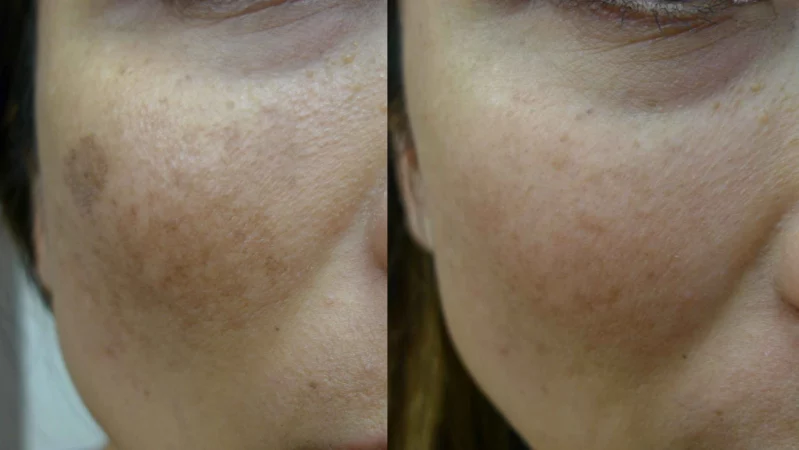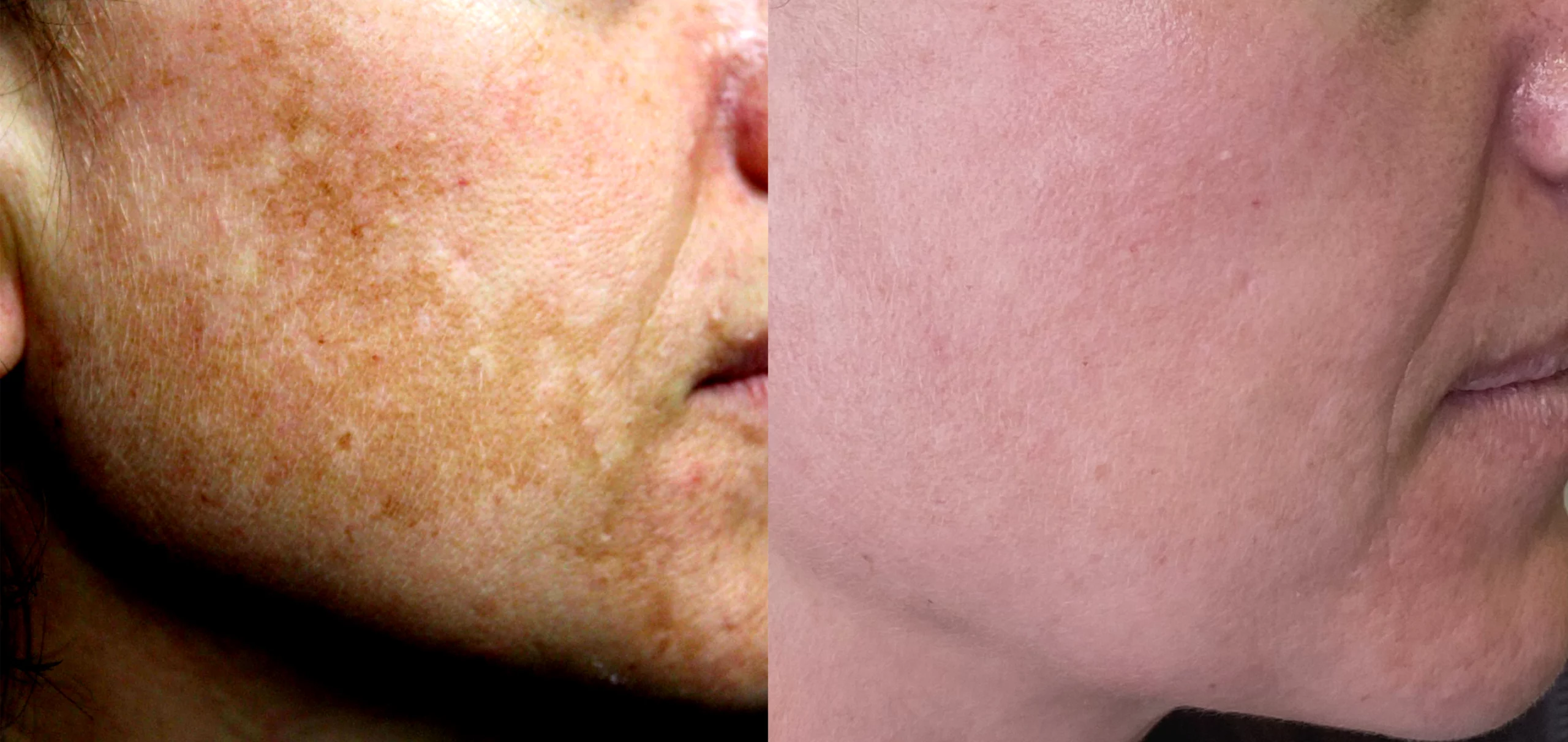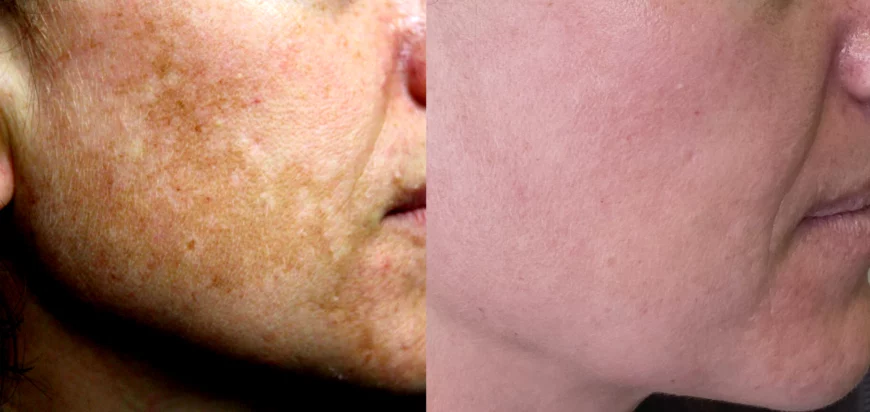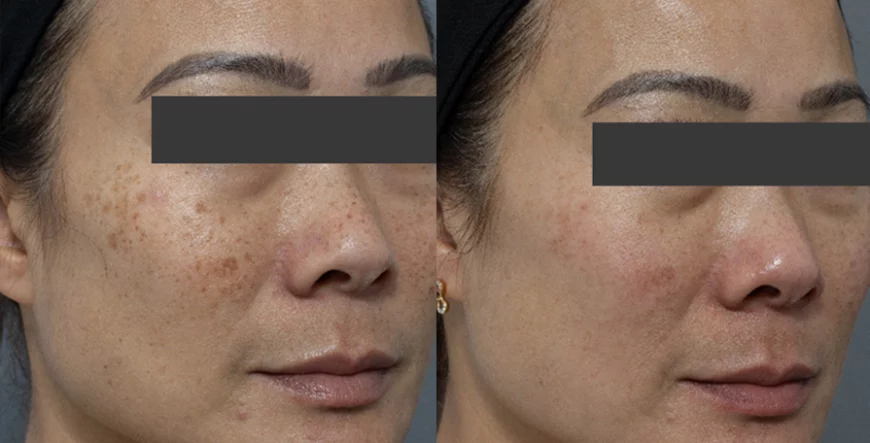Our specialist team will select one of seven pigment lasers to remove age spots safely & effectively. We combine an array of the very latest pico lasers, fractional lasers, & BBL to ensure your pigmentation is treated in the fastest possible way.
Key Points
- Age spots are best treated with specific pigment lasers
- Most cases only require one treatment
- Medical grade chemical peels are also available
- Darker/ethnic skin pigmentation are treated with pico lasers
- Cutis has both the Picoway & the Picosure Pro
- Pico lasers are the gold standard for pigmentation removal
- View our before & after gallery here
Age Spots Removal at a glance
Our results speak for themselves

Before
After

Melasma & age spots treated with 2 wavelength lasers, topicals for reducing pigment output.
Ask us more about this treatmant
Preferred Consultation

Before
After

Pico laser resurfacing
Ask us more about this treatmant
Preferred Consultation

Before
After

Picoway laser for lentigines, freckles & mixed pigment.
Ask us more about this treatmant
Preferred Consultation
FAQs
What is the best treatment for age spots?
Pigment lasers are the treatment of choice for age spots, pigmentation & sunspots. They offer precise removal of spots with minimal downtime & side effects.
For lighter skin types we use Spectra, Fraxel, CO2, Hero BBL, & pico lasers.
For darker skin types we employ Picoway & Picosure Pro lasers.
At Cutis Dermatology we select particular devices for specific spots & skin types. This ensures your pigmentation will be safely treated in the minimum number of treatments.
Does laser permanently get rid of age spots?
Lasers can treat existing spots, it does not prevent new ones from appearing.
To reduce recurrence we combine 2 or more types of lasers, if indicated. Combinations include BBL Hero with Fraxel laser, or pigment lasers with CO2 fractional resurfacing.
How to treat age spots in darker / ethnic skin?
Age spots in darker skin patients are treated with either the Picoway or Picosure Pro laser. Pico lasers give the highest clearance & minimises side effects such as post treatment pigmentation.
Treating pigmentation in darker skin types is more complex- you must use specific lasers or side effects will occur. Post treatment skin care is paramount.
Can chemical peels remove age spots?
Peels can at the very least fade, & at the most completely remove age spots & pigmentation. The peel type will depend on your skin type & diagnosis.
If you have ethnic skin, pico lasers are a better choice.
Superficial peels including glycolic, lactic & retinoic acids
Medium depth peels include: Jessner TCA peels.
Hybrid peels include: Cosmelan/ Dermamelan
| Glycolic & lactic acid | No downtime | Multiple sessions | Cost $ | Partial
removal |
| Retinoic acid | 2 day recovery | Multiple session | Cost $ | Partial
Removal/ Preventive |
| Jessner TCA | 7+ day recovery | One session | Cost $$$ | Complete removal |
| Dermamelan
Cosmelan |
4-8 day recovery | One session | Cost $$$ | Good
removal |
Can prescription skin care work?
Prescription creams can give marginal improvement of up to 20% after 10-12 weeks of continued use. Ingredients include retinol, retinoic acid, ascorbic acid, arbutin & low concentrations of alpha & beta hydroxy acids.
The optimal mix will depend on your skin type, clinical diagnosis & your skin’s sensitivities.
At what age do you start getting age spots?
Age spots, as the name suggests, increase with age. The average age is 35, however they can appear earlier or later depending on your skin type, level of sun protection & genetics.
Products

O Cosmedics cleansing range
$63.00-$64.00

O Biotics 3D Hyaluronic Serum
From $97.00
Age spots are easily removed with nano, pico or fractional lasers, depending on the depth of pigment & the quality of surrounding skin. Once treated, recurrence is rare. Anti-aging creams can prevent new age spots from developing.
Can microdermabrasion treat pigmentation?
Microdermabrasion can reduce pigmentation by removing the outer layer of dead skin cells. This improves light transmission & lightens skin. This effect can last up to 3 weeks.
The effects of microdermabrasion are temporary; however, it is a useful treatment to increase the potency of pigment correction creams.
What is the important distinction between age spots & melasma?
Melasma is a unique form of pigmentation that requires gentle treatments over time. It can respond to specific lasers, but it is best treated with medical therapy.
The best treatments for melasma include plasminogen modulators & tyrosinase inhibitors.
If you hit melasma pigmentation with high powered lasers or devices such as BBL Hero, or pico lasers, it will come back darker & worse. This is called rebound melasma. Thus, it is essential that this common form of pigment is diagnosed PRIOR to any laser treatment.
Do natural treatments work?
The biggest traction you will get out of natural remedies is with a hat & sunscreen. If would like to ‘give it a go’ you can try –
- Azelaic acid 10-20%
- Bearberry creams
- Niacinamide, vitamin B3
- Beta-arbutin from wheat & grains
- Liquorice root extracts
- Citric acid
- Green tea extract
What is so dangerous about apple cider vinegar?
Burns are frequently seen with apple cider, so think twice about using this to treat pigment & age spots. This commonly occurs with multilayering, especially in patients with a compromised skin barrier.
Can lemon juice remove age spots?
Citric acids & AHAs are derived from lemon, glycolic acid from sugarcane, so there is some merit that fruit acids can assist in skin exfoliation. The problem is that lemon contains light sensitive compounds known as furocoumarins.
Furocoumarins react with UV light, causing a phototoxic reaction. This makes pigmentation worse. Don’t treat skin pigmentation with lemon juice.
Why is diagnosis the most critical step in treating age spots?
Pigment is complex as there are nearly 200 times of pigmentation. Even under the colloquial umbrella of age spots there are many types of pigmentation disorders. For example, a lentigo is an age spot, so are macular seborrheic keratosis. Same classification, vastly different treatments.
Lentigo age spots can resolve with BBL Hero, IPL, high pass Fraxel, or simple Pico/nano lasers. Thicker macular seborrheic keratosis often requires special lasers & techniques.
Add to this, other types of pigmentation, – melasma, Hori, mixed dermal, moles, ephelides, pigmented solar keratosis, & you get the picture. Each diagnosis requires a specific treatment.
Queensland has the highest rate of melanoma worldwide, hence it is important to give a diagnosis to a pigmented age spot prior to laser. If in doubt, see a dermatologist for a skin check.
Finally, the skin type. How we manage fair skin is totally different compared to darker skin. WIth the latter we use pre & post treatment creams. The choice of laser is pico.
Why is sun protection essential after treating age spots?
No matter which treatment you choose, protecting your skin from the sun markedly improves outcomes, & reduces recurrence.
Dermatologists recommend a high factor SPF 50+ sunscreen, to be used twice a day. One bottle should last you 3 weeks (50-60ml). The use of hats, sunglasses & UV clothing are useful adjunctive treatments.


